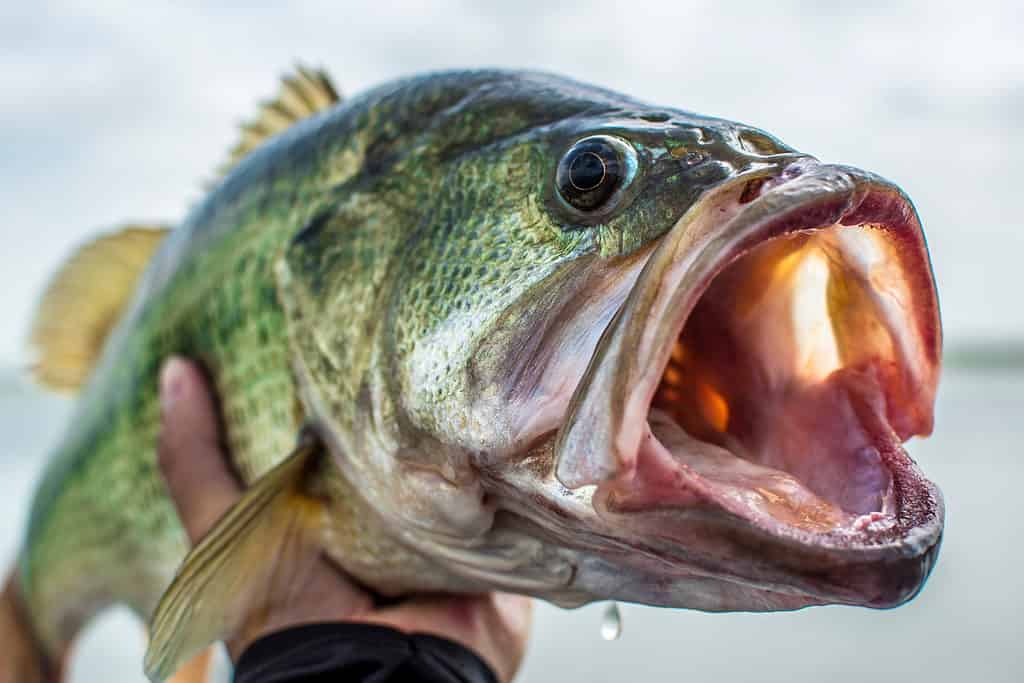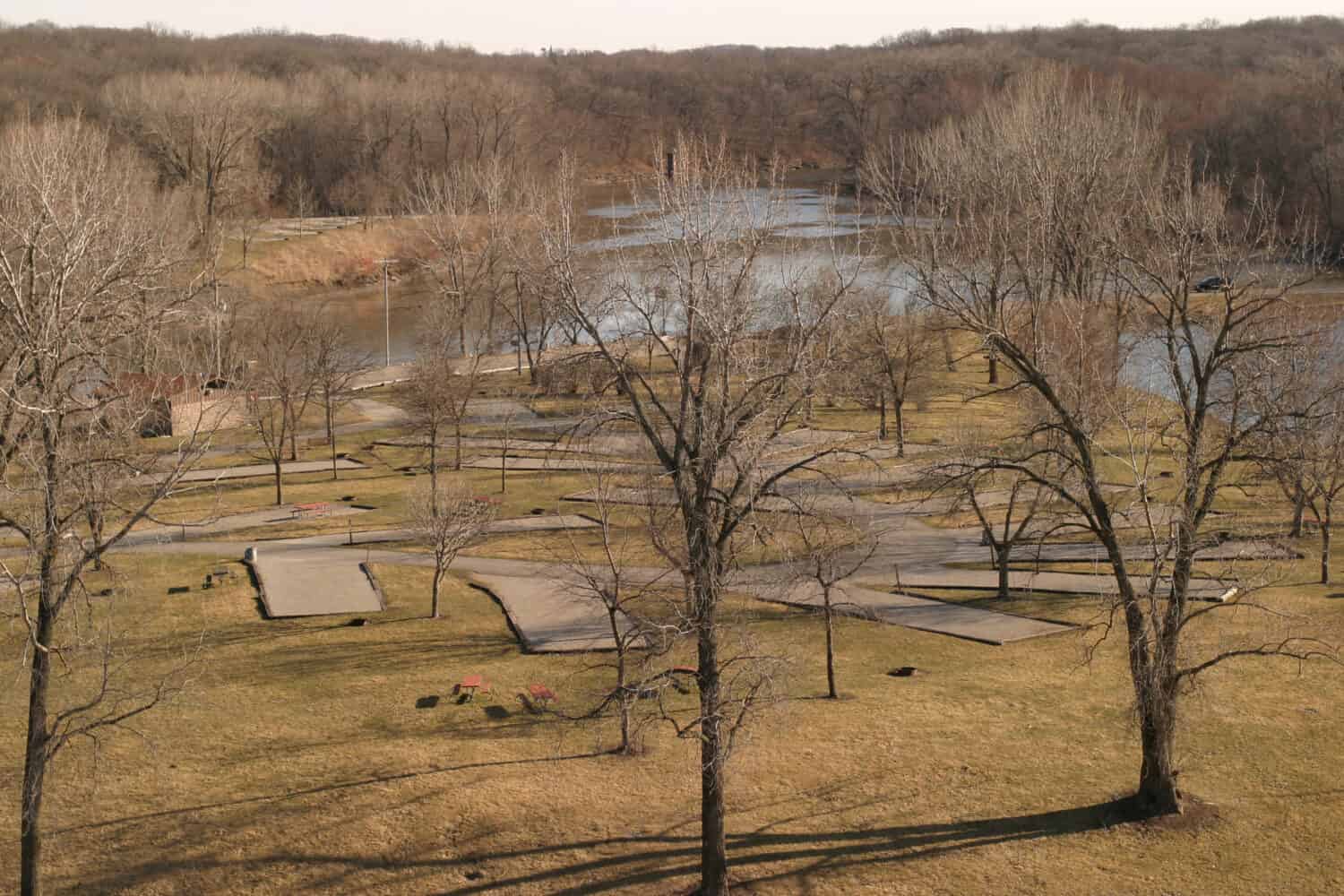While Iowa is often recognized for its sweeping farmlands and quaint small towns, it is also home to impressive infrastructure projects. The largest dam in Iowa is the Coralville Dam, an engineering marvel that holds back the waters of the Iowa River near Coralville.

A Massive Structure Built for Flood Control
The Coralville Dam was built between 1949 and 1958 by the U.S. Army Corps of Engineers, primarily to prevent flooding of communities downstream along the river. In the many years since its completion, the dam has protected the area by avoiding over one billion dollars in potential flood damages. At maximum capacity, the reservoir held back by the dam contains a massive 461,200 acre-feet of water. That’s enough water to blanket 60,000 football fields with a foot of water across each field. Storing such an enormous quantity of water provides vital flood control downstream and allows for recreation on the reservoir that residents and tourists enjoy.
A New Lake Brought New Wildlife
Before the Coralville Dam was built, the Iowa River valley was prone to flooding. The river would swell over its banks regularly, wreaking havoc on the surrounding farmlands and communities. The floods prevented much development close to the river.
The new Coralville Lake flooded that valley after the dam was built. The creation of the reservoir flooded over 5,000 acres of land. Although detrimental for some local farmers, the new lake habitat attracted new fish, bird, and other animal species to populate the area.
These days, Coralville Lake is a haven for all sorts of creatures. Let’s take a look at some of the wildlife that now calls the lake home:

Largemouth bass are frequently in the Iowa dam.
©Pierre Rebollar/Shutterstock.com
Fish
You can find game fish like largemouth bass, bluegill, crappie, walleye, catfish, and more. The Iowa Department of Natural Resources oversees the lake’s fish populations, working to maintain a balance between sport fishing prospects and the conservation of native fish species.
The lake has many game fish to attract anglers. But there are also cool native fish like the crystal darter, a tiny fish that grows no larger than 2 inches. Protecting the habitat for these little native fish brings diversity to the ecosystem.
Birds
Birdwatchers flock to Coralville Lake to spot feathered residents and migrants alike. Over 285 species of birds are at the lake and its marshy shores. The lake is an essential stopover for migratory waterfowl like ducks, geese, herons, pelicans, and shorebirds.
Bald eagles frequently hunt along the lakeshore, and osprey nest on platforms specially built for them by the Army Corps of Engineers. The reservoir’s fluctuating water levels also create excellent habitat conditions for shorebirds.
Mammals
Of course, the lake has more than just fish and birds living near its waves. Muskrats, minks, and beavers all reside along the wooded shorelines. Keep your eyes peeled on night drives for skunks, opossums, raccoons, and whitetail deer.
And while the American bison no longer roam Iowa, they introduced a small herd at Coralville Lake for educational purposes. Bison once depended on the natural seasonal flooding of prairie rivers to create ideal grazing habitats.

Camping is one of the fun activities do near Coralville dam.
©Madeleine Openshaw/Shutterstock.com
Recreation for All
Beyond appreciating the wildlife at Coralville, visitors flock here to boat, fish, camp and enjoy the beautiful scenery. Let’s explore some of the top recreational activities available:
Boating
Coralville Lake is a boater’s paradise with over 5,000 acres of sparkling blue water. All types of vessels cruise the lake’s surface, from speedy motorboats to graceful sailboats to serene kayaks. Five public boat ramps grant access to launch your boat.
At the helm, remember to boat safely and responsibly. Certain areas have speed limits to avoid disturbing anglers and waterfowl with large wakes. Buoys mark shallow spots and other hazards to steer clear of. Tragically, deadly accidents have occurred on the lake in the past. Wearing life jackets and avoiding alcohol while operating a boat are absolute musts.
On a calm summer day under sunny skies, you can’t beat time spent boating on Coralville Lake. Pack a picnic lunch and drop anchor at a scenic cove to swim and relax. Troll for fish off your back deck while taking in the fresh air. Sail across the lake, weaving between other boaters. Or paddle a kayak along the tree-lined shore for an intimate perspective. However you choose to experience the lake, boating here makes for an unforgettable Iowa adventure.
Camping
For the ultimate Coralville Lake experience, camping overnight allows you to fully appreciate beauty day and night. Several parks dotting the lakeshore offer campsites, with amenities ranging from full-service RV hookups to rustic, hike-in tent spots.
Wake to golden sunrises over the water right from your tent. Build a crackling campfire in the evening and roast marshmallows under a canopy of stars. Explore the forests on foot by day and listen to loon calls over the peaceful lake at night.
Just check current water levels before pitching your tent close to shore – heavy rains can cause the lake to swell and flood campgrounds. Carefully choose your campsite above the normal high water mark.
Whether you prefer an afternoon paddling from camp to secluded coves or relaxing in a hammock strung between trees, camping immerses you in the natural beauty of Coralville Lake. Sleeping under the stars with the lake just steps away makes for precious memories to last a lifetime.
Trails
What better way to experience Coralville Lake than on the miles of hiking and biking trails? Winding paths follow the lakeshore, climb wooded bluffs, and traverse wetland boardwalks for up-close nature encounters.
For a unique perspective, walk across the top of the Coralville Dam itself. Take in the panoramic views across the vast lake and verdant Iowa River valley that the dam’s engineering made possible. Trails also lead to historic relics like the 19th-century Mehaffey Bridge, reminding us of the area’s past.
Pack a daypack and hit the trails to spot wildlife, discover hidden coves, and gaze over sparkling waters. Ramble down trails through oak savannas ablaze with wildflowers in spring. Mountain bike through maples and sycamores turning fiery hues in fall. Snowshoe across frost-covered fields on winter mornings. However you choose to explore, the trails offer adventure across all seasons.
Immerse yourself in the essence of Coralville Lake by strapping on hiking boots or hopping on a bike. Let the trails take you on a journey where natural beauty and human history intersect at this Iowa treasure.

If the dam broke, it would unleash 200,000 acres of water.
©Madeleine Openshaw/Shutterstock.com
What Would Happen If the Coralville Dam Ever Broke?
The Coralville Dam is an impressive structure that holds back the waters of the Iowa River and provides substantial flood protection downstream. But what would happen if this vital dam ever failed and unleashed the reservoir behind it? It’s an alarming concept to ponder, but essential to understand the potential impacts of such an event.
A Catastrophic Breach
Modern dams have stringent standards, but disasters still happen. Heavy flooding, earthquakes, structural failures, or even sabotage could cause the Coralville Dam to be breached. A full breach event would rapidly unleash the lake’s over 200,000 acre-feet of stored water.
Engineers estimate that if the dam fully failed, the discharge would be over 1 million cubic feet per second! For comparison, Niagara Falls has a flow of only 150,000 cfs. The catastrophic flooding downstream would be unprecedented.
Floodwaters Raging Downstream
All that water rushing from Coralville Lake would create a swiftly moving flood wave surging downstream along the Iowa River. The wave would devastate riverside communities and farm fields along its path of destruction.
Johnson County communities like Coralville, Iowa City, Hills, and Lone Tree would likely see floodwaters over 25 feet deep scouring through town. Anything not reinforced to withstand the impact could be torn apart or swept miles downstream by the violent currents. Vehicles, livestock, and even people would be at risk in the raging waters.
But it’s not just the nearby cities that would be impacted. The flood wave would continue downstream, growing as other rivers and tributaries added their waters to the swollen Iowa River. Cities further south, like Wapello, Columbus Junction, and even as far as Burlington, over 150 miles away, would likely see record flooding.
Costly Infrastructure Damage
The powerful floodwaters would cause immense damage to infrastructure like buildings, roads, bridges, rail lines, pipelines, dams, levees, and electric utilities across a wide swath of the state. The costs to repair or replace damaged infrastructure could easily reach billions of dollars.
Several towns would be virtually destroyed in the deluge. Many homes, businesses, and municipal buildings would likely at a complete loss from the tremendous impacts of such a large inundation. Parts of downtowns might have to be re-built from scratch after the waters recede.
Agricultural Losses
Iowa’s prime farmland would also bear the brunt of the flooding. Over a million acres of cropland could potentially be scoured and covered in sediment and debris. Entire harvests of corn and soybeans would be completely lost ahead of the growing season.
The raging rivers could displace, cause injuries, or drown the livestock. The infrastructure damage would disrupt the transport of agriculture products to markets. Farmers all along the Iowa and Mississippi Rivers would suffer severe financial consequences that could drive some out of business entirely.
Environmental Contamination
Floodwaters would carry untold amounts of hazardous contaminants from roads, industries, rail yards, storage tanks, chemical facilities, waste sites, and more. Sewage treatment plants and pipes would likely be overwhelmed, releasing raw sewage. These pollutants would end up coating the floodplains across a wide area after the waters recede.
The contamination could drastically impact water quality in the region for years. Groundwater drinking water wells could be toxic. Contaminated sediments left behind would make agriculture and redevelopment challenging. They would need extensive environmental testing and remediation.
Loss of Life
As catastrophic as the infrastructure and economic damages would be, any loss of human life is always the greatest tragedy. While warning systems and evacuations would hopefully minimize the death toll, it is likely that people still sheltering in place or trapped by floodwaters would lose their lives in a massive dam failure event.
Infrastructure damage could also disrupt emergency services, hampering rescue efforts. In a worst-case scenario breach event, hundreds or even thousands of deaths are not out of the question. Public awareness and emergency action plans help reduce loss of life risks when disaster inevitably strikes.
Staying Prepared
While alarming, being aware of the potential impacts of a dam failure can help communities be as prepared as possible. Monitoring flood risks, improving warning systems, identifying evacuation routes, and educating citizens on flood response can all help minimize damages and casualties if the Coralville Dam fails catastrophically.
Thankfully dam failures are extremely rare, especially for large dams like Coralville that are regularly inspected and maintained. But it never hurts to be prepared for any possibility, no matter how slim. The more prepared we are, the more resilient our communities can be in a disaster.
Conclusion
The Coralville Dam, the largest dam in Iowa, is an impressive feat of engineering that provides critical flood protection along the Iowa River. The massive earthen dam is a testament to infrastructure projects protecting communities from natural disasters. While dam failure could be catastrophic, diligent maintenance and emergency preparedness minimize that dire risk.
The lake formed behind the dam tames floodwaters and provides a beautiful oasis where diverse wildlife now thrives. From recreation opportunities to the engineering marvel of the dam itself, Coralville is a treasure for all Iowans to appreciate. With proper stewardship, it will continue benefitting generations to come.
The photo featured at the top of this post is © Madeleine Openshaw/Shutterstock.com
Thank you for reading! Have some feedback for us? Contact the AZ Animals editorial team.







